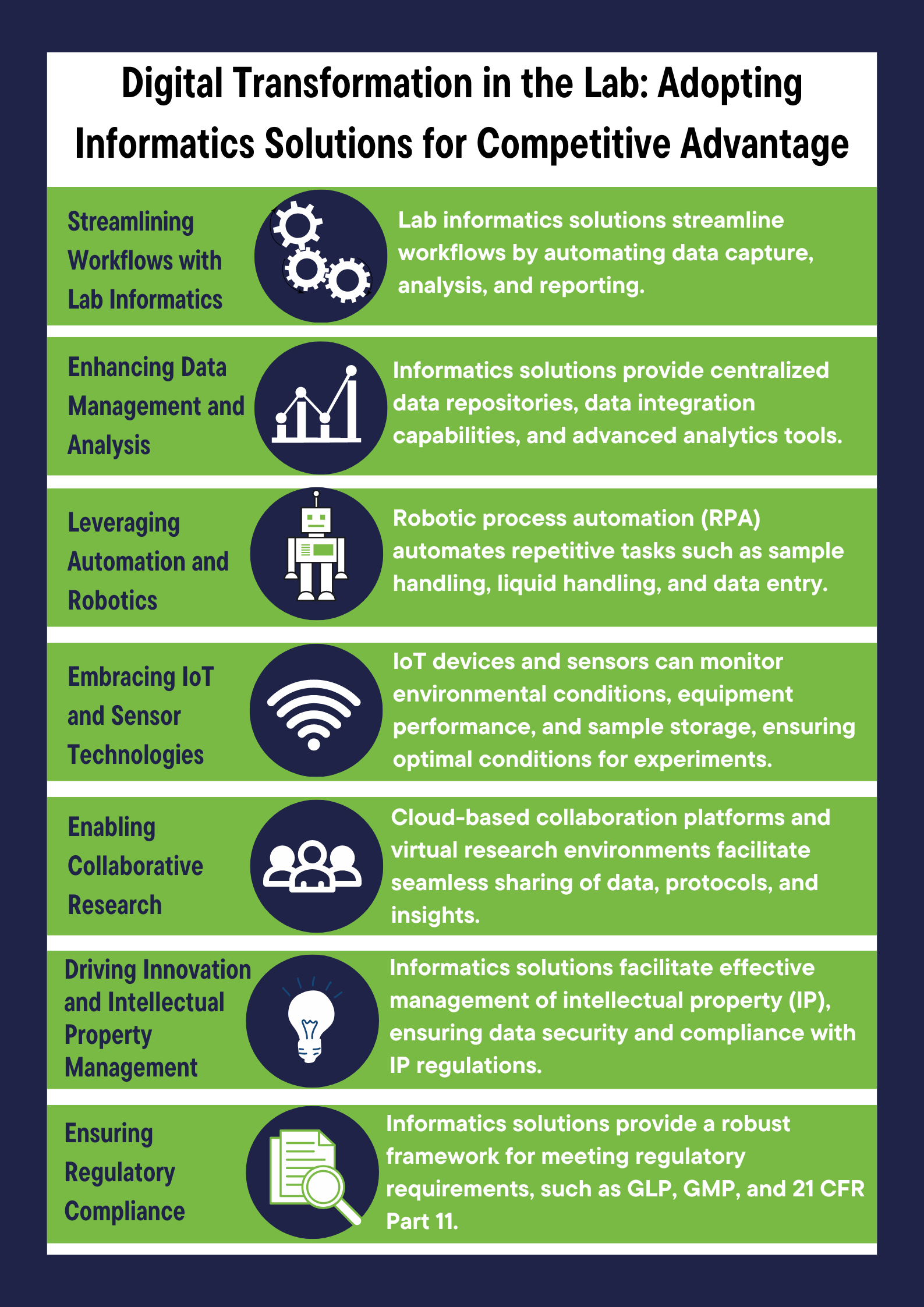Introduction
To stay competitive in today's constantly changing scientific landscape, laboratories must adopt digital transformation. By adopting cutting-edge informatics solutions, labs can optimise operations, streamline workflows, prioritise data management, and fuel innovation. This article delves into digital transformation within the laboratory, providing real-world examples of how informatics solutions can give a significant edge in the competitive scientific arena.
The Need for Digital Transformation
Conventional laboratory procedures often depend on manual processes, paper-based documentation, and standalone instruments. However, these current practices hinder efficiency, data integrity, and collaboration. For example, a lab conducting drug discovery may struggle with managing vast amounts of experimental data, resulting in delays and potential errors.
Digital transformation offers a pathway to overcome these challenges and unlock the full potential of laboratory operations.

- 1. Streamlining Workflows with Lab Informatics:
- 2. Enhancing Data Management and Analysis:
- 3. Leveraging Automation and Robotics:
- 4. Embracing IoT and Sensor Technologies:
- 5. Enabling Collaborative Research:
- 6. Driving Innovation and Intellectual Property Management:
- 7. Ensuring Regulatory Compliance:
Lab informatics solutions streamline workflows by automating data capture, analysis, and reporting.
For instance, a pharmaceutical lab implementing an Electronic Laboratory Notebook (ELN) can enable real-time research collaboration, ensuring seamless knowledge sharing and version control. Laboratory Information Management Systems (LIMS) can help a diagnostics lab track samples, manage inventory, and schedule experiments efficiently, optimizing resource utilization.
Digital transformation can enable labs to manage vast amounts of data efficiently. Informatics solutions offer centralized data repositories, capabilities for integrating data, and advanced analytics tools.
For example, a genomics lab can leverage informatics solutions to integrate and analyse large-scale genomic datasets, identifying patterns and potential therapeutic targets faster and more accurately.
Automation and robotics play a vital role in digital transformation within the lab. Robotic process automation (RPA) handles repetitive tasks like sample manipulation, liquid handling, and data input, thus allowing researchers more time for higher-value activities.
For instance, a lab that implements robotic systems for high-throughput screening can accelerate the identification of potential drug candidates and improve research productivity.
Lab operations are being impacted by the Internet of Things (IoT) and sensor technologies. IoT devices and sensors can monitor environmental conditions, equipment performance, and sample storage, ensuring ideal conditions for experiments.
For example, a labs can utilize IoT sensors to monitor temperature and humidity in storage facilities, maintaining sample integrity and reducing the risk of experimental failure.
Digital transformation fosters collaboration among researchers, both within and across organizations. Cloud-based collaboration platforms and virtual research environments facilitate the seamless sharing of data, protocols, and insights.
For instance, a multi-site project can leverage cloud-based informatics solutions to enable real-time collaboration, data sharing, and joint analysis, enhancing research efficiency and enabling breakthrough discoveries.
Digital transformation drives innovation by facilitating rapid experimentation, data integration, and knowledge sharing. Informatics solutions enable effective Intellectual Property (IP) management, ensuring data security and compliance with IP regulations.
For example, scientists can utilize informatics tools to capture research findings, streamline patent filing processes, and safeguard valuable innovations.
Digital transformation can help labs maintain regulatory compliance by automating data integrity controls, audit trails, and documentation processes. Informatics solutions provide a robust framework for meeting regulatory requirements, including Good Laboratory Practice (GLP), Good Manufacturing Practice (GMP), and 21 CFR Part 11.
For instance, a validated labs can implement informatics solutions to ensure data integrity, traceability, and compliance with industry regulations, reducing the risk of compliance violations and associated penalties.
Conclusion:
Digital transformation has become an essential strategy for laboratories seeking a competitive advantage in the scientific landscape. Labs can optimize workflows, enhance data management, drive collaboration, and foster innovation by adopting informatics solutions. By fully harnessing technology, labs can proactively remain at the forefront by adopting such digital approaches.
If you're interested in digital transformation technologies and laboratory process transformation, please get in touch with us at info@zifornd.com


